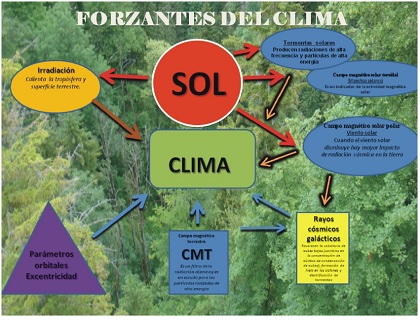Probable conexión entre el comportamiento del Campo Magnético Terrestre y cambios climáticos durante el Cenozoico Tardío
Autores:
María Julia Orgeira, Silvia Duahu, Claudia Gogorza, Ana M.Sinito
Año de la publicación:
2 013
Revista:
Latinmag Letters, Volume 3, Special Issue (2013), OD01, 1-4. Proceedings Montevideo, Uruguay
Resumen:
Aunque la actividad solar y los ciclos orbitales son los forzantes climáticos más importantes reconocidos
al presente, otras variables están cobrando relevancia en los últimos tiempos (fig. 1). La actividad de Sol es
claramente un importante factor de cambios, no sólo en el clima, sino también en el comportamiento de la
ionosfera, la magnetósfera, y el campo geomagnético externo (Courtillot et al, 2007). Este campo modula
el flujo entrante de rayos cósmicos galácticos, los cuales se reconocen como un potencial forzante del
clima. Variaciones a intervalos regulares del campo magnético terrestre acaecidas en los últimos milenios
parecen estar correlacionados con eventos climáticos significativos en el este de la región del Atlántico
Norte (Courtillot et al, 2007). Debido a ello, se sugiere un mecanismo por el cual el campo magnético
interno en sí podría desencadenar importantes cambios climáticos, posiblemente a través de la relación
radiación cósmica, ó a la modulación de los vórtices polares conjuntamente con la actividad solar.
Luego, por una parte el campo geomagnético (CMT) modula la entrada de radiación cosmogénica y por otra,
existe una correlación entre la radiación cosmogénica y la cobertura de nubes, entre otras variaciones del
clima. Pero el proceso no es simple y la relación mencionada parece seguir un patrón geográfico, con áreas
de correlación altamente significativa y correlación casi nula en otras áreas. En síntesis, hay dos hipótesis
principalmente propuestas al presente sobre la influencia del CMT, la más lineal que indica que a menor
intensidad de campo habría más ingreso de radiación (entre ellas la cósmica), más formación de nubes, lo
cual induciría clima más frío. Y la otra que asocia el tema a la presencia de “jerks” y está relacionada con
cambios bruscos simultáneos de intensidad y dirección. Esta tiene en cuenta la inclinación del dipolo, o sea
la componente ecuatorial. Si esa componente es importante, la radiación cósmica llegaría a latitudes más
bajas, donde hay mayor humedad y eso produciría más nubes y enfriamiento del clima, lo que puede pasar
en aumentos o disminuciones de intensidad. Una combinación de ambos procesos también es factible.
Por otra parte, cuando la intensidad del dipolo axial del CMT es alta la influencia en el clima está directamente
vinculada a la actividad del sol, en períodos de actividad solar mínima el clima se enfría y por el contrario,
con actividad máxima se calienta.
En la presente contribución se muestran algunos ejemplos con correlación positiva y negativa entre
comportamiento de CMT y paleoclima, teniendo en cuenta las hipótesis propuestas al presente.
Abstract:
Although solar activity and orbital cycles are the most important climate forcing, other variables are becoming
significant in recent times. The sun activity is clearly a significant driver of changes, not only in climate
but in the behaviour of the ionosphere and the magnetosphere, and external magnetic field (Courtillot et al,
2007). This field modulates the incoming cosmogenic ray flux which is recognized as a potential driver of
climate. Geomagnetic field variations found at irregular intervals over the past few millennia seem to be
correlated with significant climate events in eastern North Atlantic region (Courtillot et al, 2007). Due to
this, a mechanism according to which the internal magnetic field itself could somewhat trigger significant
climate changes is suggested; possibly through the cosmic ray/low cloud connection, during periods of
extreme tilt of the geomagnetic dipole, climate changes could take place.
Then, the geomagnetic field can modulate the incoming of cosmogenic ray flux. Meanwhile, there is a
correlation between cosmogenic ray and cloud cover; higher cosmogenic ray flux lead to more low clouds
and thus higher albedo and, as a consequence, lower earth surface temperatures. But the process is no
simply and the mentioned relation seems to follow a geographycal pattern, with areas of highly significant
correlation and almost no correlation in other areas. Briefly, there are two main hypotheses proposed about
the influence of the geomagnetic field; the more simply one which indicates that the lower field intensity
would promote more radiation income (including cosmic), more cloud formation, which could induce cold
weather. And the other associating the subject to the presence of jerks, and it is related to simultaneous
sudden changes in intensity and direction of the geomagnetic field. This takes into account the inclination of
the dipole, it means the equatorial component. If this component is important, cosmic radiation would reach
lower latitudes, where there is more moisture and that produce more clouds and cooler climate, which can
happen with increases or decreases in intensity of the geomagnetic field. A combination of both processes
is also posible.
On the other hand, when the axial dipole intensity is high, the influence on climate is directly linked to solar
activity; during periods of minimum solar activity the weather cools and conversely, with maximum activity
heats up.
The present contribution shows some examples with positive and negative correlation between geomagnetic
field and paleoclimate behavior, taking into account the hypothesis proposed at present.
Imagen:

